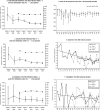'Matching Michigan': a 2-year stepped interventional programme to minimise central venous catheter-blood stream infections in intensive care units in England
- PMID: 22996571
- PMCID: PMC3585494
- DOI: 10.1136/bmjqs-2012-001325
'Matching Michigan': a 2-year stepped interventional programme to minimise central venous catheter-blood stream infections in intensive care units in England
Abstract
Background: Bloodstream infections from central venous catheters (CVC-BSIs) increase morbidity and costs in intensive care units (ICUs). Substantial reductions in CVC-BSI rates have been reported using a combination of technical and non-technical interventions.
Methods: We conducted a 2-year, four-cluster, stepped non-randomised study of technical and non-technical (behavioural) interventions to prevent CVC-BSIs in adult and paediatric ICUs in England. Random-effects Poisson regression modelling was used to compare infection rates. A sample of ICUs participated in data verification.
Results: Of 223 ICUs in England, 215 (196 adult, 19 paediatric) submitted data on 2479 of 2787 possible months and 147 (66%) provided complete data. The exposure rate was 438 887 (404 252 adult and 34 635 paediatric) CVC-patient days. Over 20 months, 1092 CVC-BSIs were reported. Of these, 884 (81%) were ICU acquired. For adult ICUs, the mean CVC-BSI rate decreased over 20 months from 3.7 in the first cluster to 1.48 CVC-BSIs/1000 CVC-patient days (p<0.0001) for all clusters combined, and for paediatric ICUs from 5.65 to 2.89 (p=0.625). The trend for infection rate reduction did not accelerate following interventions training. CVC utilisation rates remained stable. Pre-ICU infections declined in parallel with ICU-acquired infections. Criterion-referenced case note review showed high agreement between adjudicators (κ 0.706) but wide variation in blood culture sampling rates and CVC utilisation. Generic infection control practices varied widely.
Conclusions: The marked reduction in CVC-BSI rates in English ICUs found in this study is likely part of a wider secular trend for a system-wide improvement in healthcare-associated infections. Opportunities exist for greater harmonisation of infection control practices. Future studies should investigate causal mechanisms and contextual factors influencing the impact of interventions directed at improving patient care.
Figures

Comment in
-
Recipes for checklists and bundles: one part active ingredient, two parts measurement.BMJ Qual Saf. 2013 Feb;22(2):93-6. doi: 10.1136/bmjqs-2012-001480. Epub 2012 Oct 3. BMJ Qual Saf. 2013. PMID: 23035255 No abstract available.
References
-
- Srinivasan A, Wise M, Bell M, et al. Centers for Disease Control and Prevention (CDC) . Vital signs: central line-associated blood stream infections—United States, 2001, 2008, and 2009. MMWR Morb Mortal Wkly Rep 2011;60:243–8 - PubMed
-
- O'Grady NP, Alexander M, Burns LA, et al. Healthcare Infection Control Practices Advisory Committee (HICPAC) Guidelines for the prevention of intravascular catheter-related infections. Clin Infect Dis 2011;52:e162–93 http://www.cdc.gov/hicpac/pdf/guidelines/bsi-guidelines-2011.pdf - PMC - PubMed
-
- Coopersmith CM, Rebmann TL, Zack JE, et al. Effect of an education program on decreasing catheter-related bloodstream infections in the surgical intensive care unit. Crit Care Med 2002;30:59–64 - PubMed
-
- Coopersmith CM, Zack JE, Ward MR, et al. The impact of bedside behavior on catheter-related bacteremia in the intensive care unit. Arch Surg 2004;139:131–6 - PubMed
-
- Warren DK, Zack JE, Mayfield JL, et al. The effect of an education program on the incidence of central venous catheter-associated bloodstream infection in a medical ICU. Chest 2004;126:1612–18 - PubMed
Publication types
MeSH terms
LinkOut - more resources
Full Text Sources
Medical
